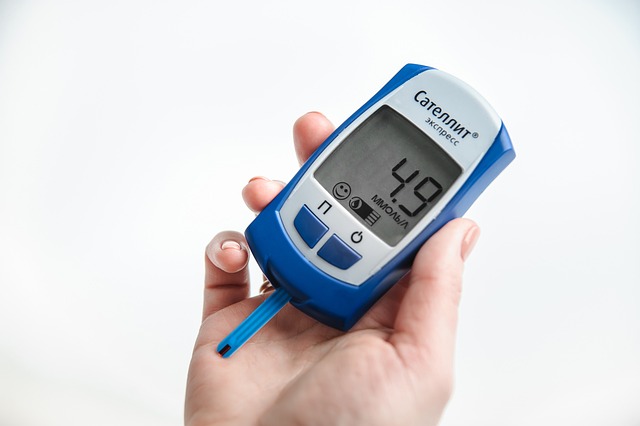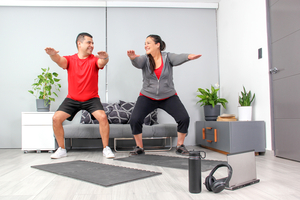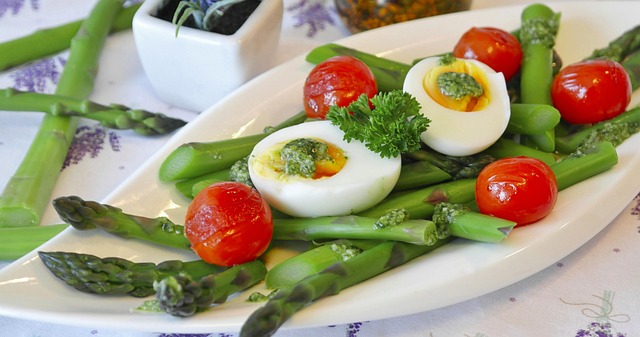In this article:
- GLP-1 medications may help with weight loss by reducing appetite, increasing fullness, and reducing a fixation on food.
- Healthcare providers prescribe GLP-1 medications as a tool along with lifestyle changes to support weight loss.
- Healthy lifestyle changes can lead to more weight loss and a reduction in common side effects from GLP-1 medications like nausea, vomiting, constipation, and diarrhea.
- Harvard researchers have published a MEAL plan, which is a strategy for lifestyle changes to succeed on GLP-1s. Read on to learn more!
- Lark is available 24/7 to help you eat healthier and achieve your health and weight loss goals with or without GLP-1 medications.
If you’re taking a GLP-1 medication for weight loss, your healthcare provider has likely given you instructions to make lifestyle changes to support your goals. Establishing healthy lifestyle habits can help increase weight loss, reduce side effects, and support long-term weight maintenance as you stop taking GLP-1 medications and beyond. Researchers from Harvard have published the MEAL plan to help people succeed on a GLP-1.
The MEAL plan is a framework that addresses the following areas.
- Muscle maintenance (M)
- Energy balance (E)
- Avoiding side effects (A)
- Liquids (L)
It’s also important to engage in Physical activity (P).
Continue reading for information on why these areas are important for individuals taking GLP-1 medications, and what you can do to support them. Be sure to talk to your healthcare provider before making any changes to your plan.
Muscle Maintenance (M)
You may lose weight faster with GLP-1 medications than without them. A lot of the weight you lose may be fat, but some may be muscle mass. Compared to slower weight loss, rapid weight loss can lead to a greater proportion of lost muscle mass compared to fat. Losing muscle can reduce metabolism and strength.
What to Do for Muscle Maintenance
Focus on dietary protein to support muscle repair and recovery to reduce loss of muscle mass. A daily goal may be 1-1.5 grams of protein per kilogram of body weight per day. For someone who weighs 200 lb, or 90 kg, that would be 90-135 grams of protein per day.
Think about including 20-30 grams of protein per meal. More than this at one time won’t further support muscle growth. Eat protein first at meals so that you still consume protein even if you fill up early and cannot finish your meal.
Here are some lean sources of protein with 20-30 grams of protein.
- 1 cup of low-fat cottage cheese
- 3-4 ounces of skinless chicken, tuna, shrimp, salmon, or other fresh fish, or other shellfish
- 3-4 ounces of lean ground turkey
- 1 ½ cups of beans or lentils
- 1-1 ½ cups of plain Greek yogurt
- 4-5 ounces of tofu
Nuts, peanuts, and seeds are nutritious options rich in protein, fiber, and healthy fats, but be mindful of portion sizes. High-fat foods can lead to side effects on GLP-1s.
Energy Balance
Energy balance determines weight loss, gain, or maintenance. A negative energy balance is when the calories that you consume are less than the calories that you burn or expend. This leads to weight loss. When you achieve your goal weight and are ready to maintain and prevent weight gain, the calories you consume should equal the calories you expend.
How GLP-1 Medications Affect Energy Balance
GLP-1s can support a negative energy balance and weight loss in these ways.
- They may reduce appetite and increase satiety, so you choose to eat less
- They can reduce cravings and obsessive thoughts about food, which makes it easier to eat less
- Some evidence suggests that they may increase metabolism, so you burn more calories
- They support more stable blood sugar, which helps reduce blood sugar swings and cravings for sugar that can result from low blood sugar
It’s also important to understand that metabolism can decrease, or you can burn fewer calories, when you lose weight. Also, weight loss on GLP-1s can lead to reduced muscle mass, which also reduces calorie burn.
Tips for Creating a Negative Energy Balance for Weight Loss
Here are some tips for supporting negative energy balance and weight loss by reducing calorie consumption and increasing calorie expenditure.
- Choose smaller portions and eat more slowly
- Consume lower calorie-dense foods first at meals, like lean proteins and vegetables
- Choose higher-fiber foods like whole grains instead of refined grains and fresh, whole fruit instead of fruit juice
- Exercise regularly to burn calories and maintain muscle mass
- Build balanced meals that include protein, fiber, and small amounts of healthy fats to stay fuller for longer. Limit sugar-sweetened foods and beverages
Here’s a sample 3-day meal plan for weight loss on GLP-1 medications. Talk to your healthcare provider about what to eat and how to structure your meals and snacks for the best results.
For best results when maintaining weight loss after you achieve your goal weight, make changes that you can sustain. Avoid extreme diets like very low-calorie or very low-carbohydrate diets unless your doctor says to follow one. It’s also easier to sustain changes when they fit into your lifestyle. Choose foods you enjoy, and avoid too much restriction.
Avoid Side Effects
Common side effects on GLP-1 medications can include nausea, vomiting, constipation, diarrhea, and heartburn. You can take steps to prevent and manage them. Be sure to talk to your healthcare provider about side effects and when they may need medical intervention.
Gastrointestinal Side Effects with GLP-1 Medications
Here are some tips for lowering your risk of side effects like nausea, vomiting, constipation, and diarrhea.
- Eat slowly and chew thoroughly
- Eat smaller meals to avoid feeling too full, which can trigger nausea and vomiting
- Choose high-fiber foods to support bowel regularity, but avoid increasing fiber too quickly, as that can lead to bloating and discomfort
- A high-fat diet can increase nausea, so avoid low-nutrient, high-fat foods like French fries and other fried foods, butter, and fatty meats.
- Keep portions small when eating nutritious high-fat foods like avocados, olive oil, and nuts
- Drink plenty of water to avoid or relieve constipation. Physical activity also helps
Simple foods can help with nausea. Whole-grain toast, whole-wheat crackers, and whole-grain cereal or oatmeal may be good choices. Drinking ginger tea is another anti-nausea strategy.
Preventing Heartburn with GLP-1 Medications
Here are some tips to lower your risk for heartburn while taking GLP-1 medications.
- Eat slowly, and keep meals small to reduce pressure on your esophagus, which contributes to acid reflux and heartburn
- Avoid fatty and fried foods like fried chicken, French fries, and fatty meat. Also, bake or steam instead of frying to reduce the fat content of your food
- Some people find that spicy foods, garlic, and onions trigger symptoms
- Acidic foods like tomatoes, vinegar, lemon juice, and salad dressings are heartburn triggers for some people
- Caffeine and alcohol may make heartburn worse
- Eat earlier in the evening and avoid lying down for 2-3 hours after meals. If necessary, sleep in a sitting position to avoid lying down if you’re still feeling full at bedtime
Each person has different triggers for heartburn, so it’s important to see which foods and flavors are safe and which are risky for you.
Liquids (L)
Water is the most important nutrient, and it has additional significance when you’re on GLP-1 medications. It can help reduce constipation, increase energy, and reduce hunger. It can also help prevent nausea.
Getting Enough Water
Harvard researchers suggest drinking 8-12 cups of fluid per day, with water being the top choice. Sparkling water, flavored water, caffeine-free herbal and black tea, caffeine-free black coffee, and low-sodium broth can also help you reach your goals. Watery foods like cucumbers, soup, and watermelon can add to your fluid totals.
Physical Activity (P)
In a MEAL Plan, Physical activity (P) is crucial for weight loss, mental and physical health, and weight maintenance. Physical activity is also critical for weight maintenance. Assuming your doctor approves, the physical activity guidelines recommend getting at least 150 minutes per week of moderate to vigorous intensity physical activity, plus 2-3 sessions per week of muscle-strengthening exercises.
Starting and Continuing Your Physical Activity
If you’re not already meeting guidelines, Harvard Researchers suggest taking these steps as you work towards achieving them.
- Work towards 150 minutes per week of moderate to vigorous intensity physical activity. Start with as little as you need for safety, such as 5 minutes a day if you’re not in shape for more. Then gradually increase to 150 minutes per week over several weeks or months
- Next, add muscle-strengthening exercises 2-3 times a week. Ask an expert for help with form and types of exercises to perform. Resistance bands, weights, and body weight exercises can all work
- Maintain your progress by including daily aerobic activity along with 2-3 times weekly strength training sessions
To make physical activity more sustainable, choose activities that you enjoy. Consider finding exercise buddies to increase motivation and accountability, and schedule workouts in your calendar to save time.
How Lark Can Help
GLP-1s can support weight loss, but they’re only one tool in your toolbox. Lark can help you make more small changes to improve heart health, lose weight, and manage or prevent chronic conditions. Your Lark coach is available 24/7 for encouragement, nutrition and physical activity coaching, and habit tracking. Lark can help you make healthy choices and establish habits that fit into your lifestyle so you can lose weight and keep it off with or without GLP-1 medications.
Click here to see if you may be eligible to join Lark today!











.webp)







